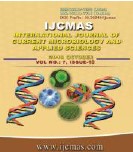


 National Academy of Agricultural Sciences (NAAS)
National Academy of Agricultural Sciences (NAAS)

|
PRINT ISSN : 2319-7692
Online ISSN : 2319-7706 Issues : 12 per year Publisher : Excellent Publishers Email : editorijcmas@gmail.com / submit@ijcmas.com Editor-in-chief: Dr.M.Prakash Index Copernicus ICV 2018: 95.39 NAAS RATING 2020: 5.38 |
Bacterial infections caused by multidrug resistant bacteria (MDR) are a constant challenge for physicians throughout the world. We processed 451 clinical samples (blood, urine, pus and body fluids) from pediatric patients during the period of July’11 to Oct’11 in Sassoon General Hospital, Pune. Objective is to identify the bacterial isolates from different clinical specimens and study their antibiotics susceptibility pattern. Bacterial infections could be detected in 155 (34.4%) patients. These bacteria were isolated from blood (61%), urine (23%), pus (14%) and body fluid (2%). 64.6% of the infections were from the ward and 35.5% from NICU. 88.4% were gram negative bacilli and 11.7% were gram positive cocci. The most common gram negative bacilli isolated were Pseudomonas aeruginosa (22%) followed by Escherichia coli (15.5%) and Klebsiella pneumoniae (15.5%). 62% of the isolates were MDR, of which 33% were carbapenemase producers. Among the non-fermenters 3.3% organisms were resistant to all drugs including colistin and polymyxin –B. Increasing drug resistant organisms emerging in health care settings is prolonging hospital stay and increasing the cost of health care. So there is an urgent need to formulate guidelines and rationalize the use of antibiotics curtail this pandemic of drug resistance.
 |
 |
 |
 |
 |